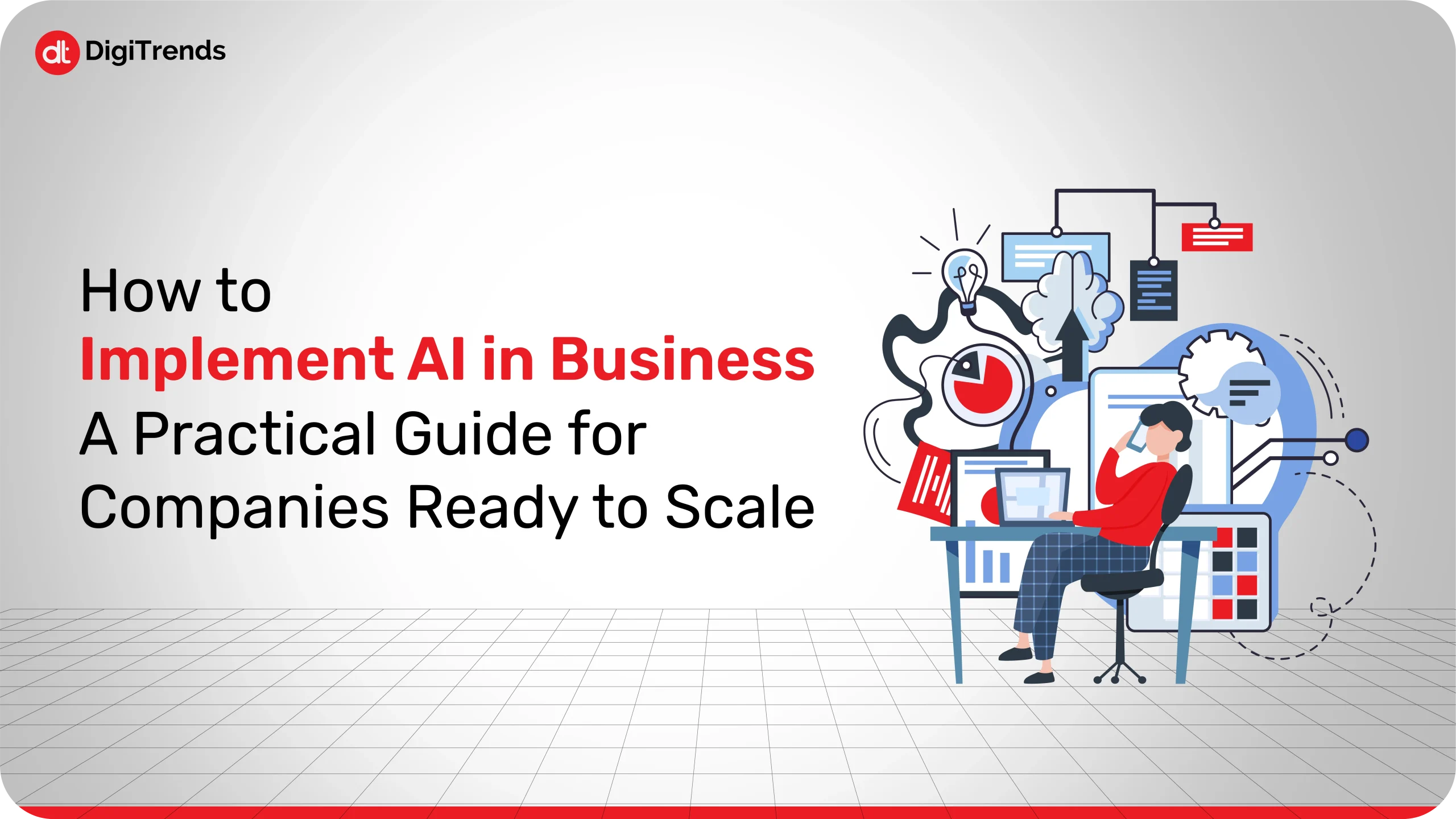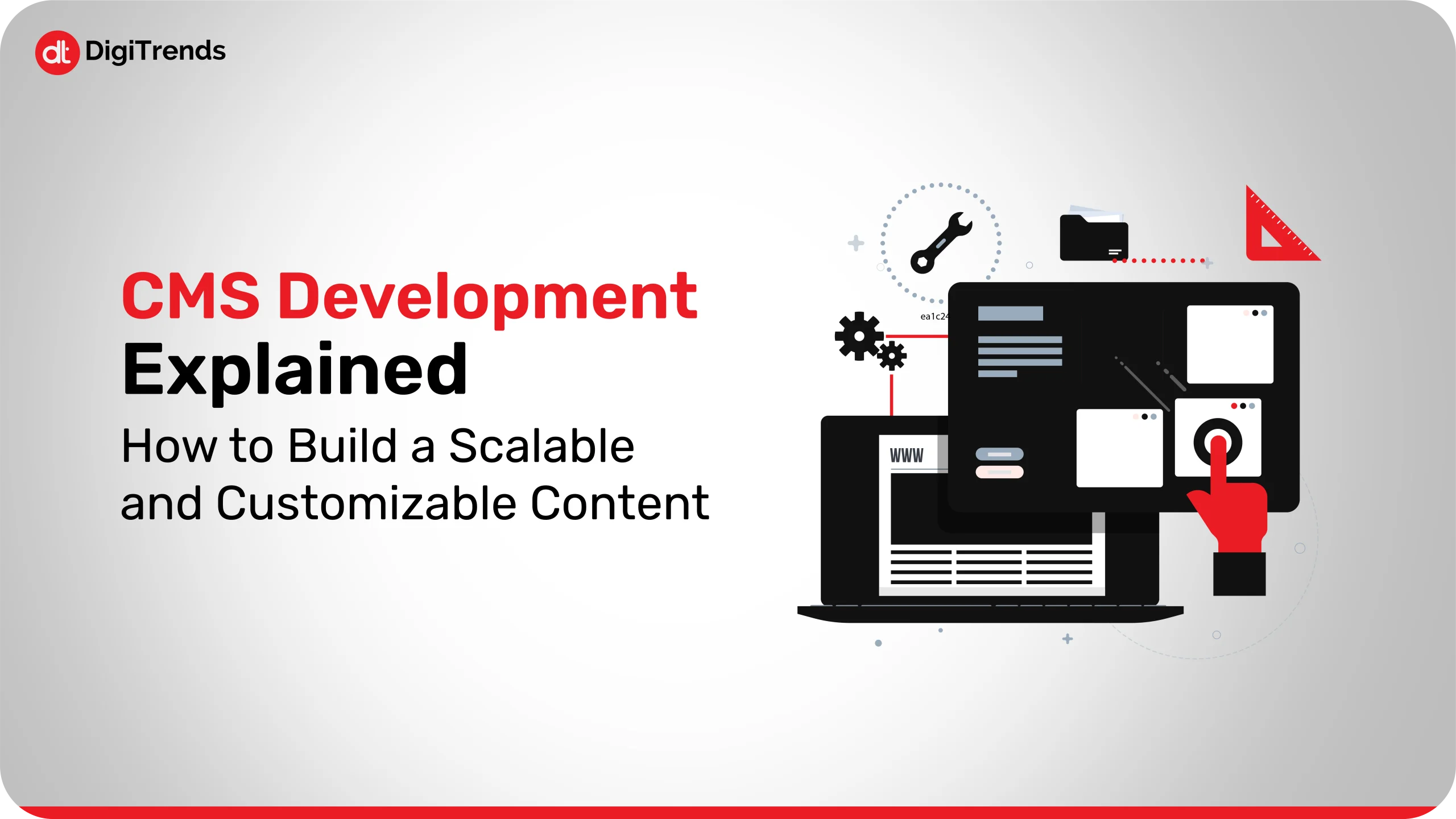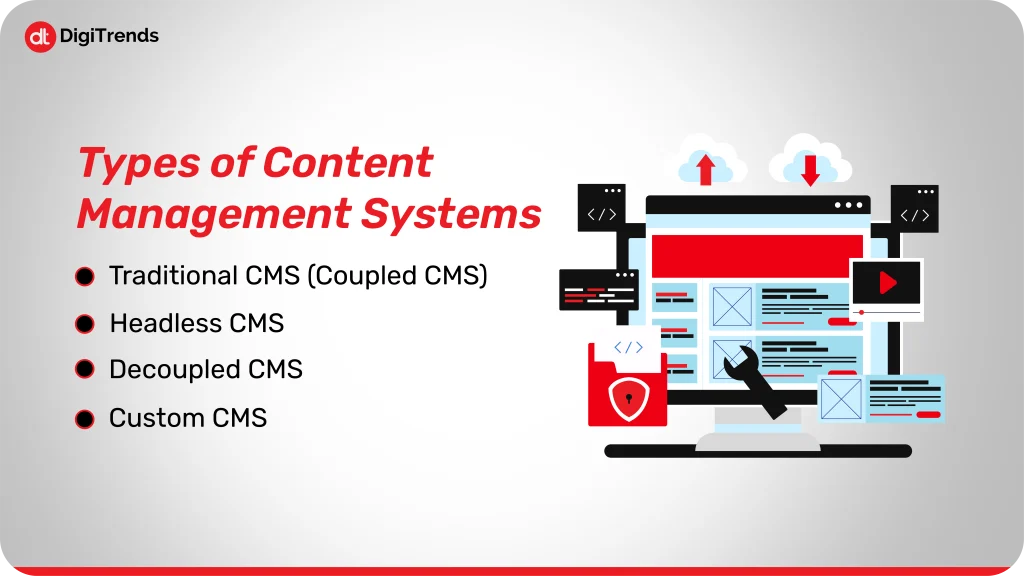
How to Implement AI in Business: A Practical Guide for Companies Ready to Scale
This guide will provide you with a simple, practical, and structured roadmap to implement AI in business.
Continue Reading
Ever wondered which software powers the websites you visit, from small blogs to enterprise?
All of it is run on one thing: a Content Management System (CMS)
CMS is a tool that helps create, edit, and publish content without writing any code. But not all CMS platforms are the same; some platforms are too rigid, others are too complex, and many businesses eventually outgrow off-the-shelf systems like WordPress or Joomla.
That’s where CMS development comes in; it helps in the process of building a custom, scalable, and flexible content system that is specially made for the unique goals of the company.
Explore what CMS development really means, how it works, what technologies power it, and how you can build your own content management system step by step.
CMS development is basically the process of designing, building, and deploying a content management system. This software allows users to manage digital content efficiently, without any use of coding.
This system acts as the backbone of a website as it lets users update text, images, and media instantly.
A CMS usually consists of two main parts:
1. Content Management Application (CMA): This is the user-facing interface where non-technical users add or edit content, like drafting content for the blog or articles.
2. Content Delivery Application (CDA): This is the backend engine that compiles, stores, and displays the content to users on the website. For example, the blogs you see on a website.
When a CMS development company builds a system, it focuses on three main goals:
1. Ease of use: They make sure anyone can manage content, not just developers.
2. Scalability: When traffic increases, the system should be able to handle growing traffic, new features, and evolving content needs.
3. Customization: It should adapt to the brand’s workflow and design requirements.
Many organizations stick to pre-built platforms for their content management, such as WordPress, Drupal, and Shopify.
But here’s the thing: These platforms work fine until the business starts growing, because after growth, limitations start showing up, such as plugin overload, performance issues, security vulnerabilities, and lack of flexibility.
That’s when custom CMS development becomes a smarter option.
Here’s why businesses often choose to build their own CMS:
1. Tailored Features: With CMS development, your business gets exactly what it needs, nothing more, nothing less.
2. Better Security: No third-party plugins or open-source vulnerabilities.
3. Faster Performance: A CMS optimized for the workflows runs cleaner and faster.
4. Long-Term Cost Efficiency: Businesses can save on licensing fees and plugin updates in the long run.
5. Full Control: Design, functionality, integrations, everything stays under the command of the organization.
If you are looking to build a CMS for your organization, consider hiring a CMS development company, as they’ll first analyze your requirements, content structure, and audience before suggesting whether to build from scratch or customize an existing framework.

Before we explore the CMS web development process, let’s have a look at the different types of CMS platforms that exist.
This CMS is the most common one. In this system, everything from content creation, management, to display, happens in one system.
Examples: WordPress, Drupal, Joomla.
Pros: Easy setup, simple editing.
Cons: Limited flexibility for scaling and integrating with new technologies.
In a headless CMS, the backend (content storage) and frontend (presentation layer) are separated, and the content is delivered through APIs to any platform, web, mobile, or IoT.
Examples: Strapi, Contentful, Sanity.
Pros: Scalable, flexible, great for multi-platform content delivery.
Cons: Requires more development work and expertise.
Decoupled CMS is a hybrid approach where the backend and frontend are separate but connected through a publishing API.
Pros: Better security and scalability than traditional CMS, but easier than a fully headless CMS.
Cons: Requires slightly higher setup and maintenance effort.
A custom CMS is built entirely from scratch or using a framework. A custom CMS development approach gives you total control over performance, design, and structure.
Pros: Perfect fit for business needs.
Cons: Higher initial development cost, but excellent ROI in the long term.
A good CMS will make content creation and management intuitive. Let’s have a look at the must-have features your content management system development should include:
1. User-Friendly Dashboard: A clean interface for editors, marketers, and admins.
2. Content Editor (WYSIWYG): A “what you see is what you get” editor for easy content updates.
3. Media Management: Upload, organize, and optimize images, videos, and files.
4. Custom Roles & Permissions: Manage who can create, edit, approve, or publish.
5. SEO Tools: Built-in meta tags, URL customization, and sitemap generation.
6. Multilingual Support: Essential for global businesses.
7. APIs for Integration: Connect with CRMs, eCommerce tools, analytics platforms, etc.
8. Scalability: Should handle increased content and user traffic effortlessly.
9. Security Controls: Authentication, data encryption, and secure access control
10. Analytics and Reporting: Insights on content performance and engagement.
A reliable CMS development company ensures these features are prioritized and well-implemented for your use case.
Let’s have a look at how CMS development services build a functional, scalable content management system from scratch.
Every development process starts with understanding what your business needs.
Before CMS development, you should know about these things:
Integration with other tools (e.g., CRM, analytics)
Once you’re sure about all your requirements, the content management system development team designs the architecture.
They will decide whether to go for a monolithic, headless, or modular structure.
Database design, data flow, and content modeling are also finalized at this stage.
This step covers the presentation part, which means how your content will look to users.
Developers use technologies like React, Vue.js, or Angular for dynamic and responsive UI.
This is what the main part of CMS development is.
Developers build the backend using frameworks like Laravel, Django, Node.js, or .NET Core.
It handles:
The next step is to choose the right database, which is also a very crucial part of the process.
Common choices include: MySQL, PostgreSQL, or MongoDB, depending on content structure and scalability goals.
At this step, the modern CMS connects with multiple tools, from marketing automation platforms to analytics.
Developers build RESTful or GraphQL APIs to enable smooth data flow.
Before launch, the CMS web development team performs extensive testing:
Once everything is tested and approved, the CMS is deployed on a live server.
But custom CMS development services don’t stop there; the custom systems also handle regular updates, security patches, and scalability improvements.
If you are someone looking to build in-house, finding the right CMS development company will make all the difference for you.
Here’s what you should look for:
1. Experience Across Industries: Get to know if they have built CMS systems for businesses like yours
2. Technical Expertise: Check their technical expertise, like their proficiency in frameworks like Laravel, React, Node.js, etc.
3. Customization Capability: Analyze if they can tailor the CMS to your workflows?
4. Security Standards: Look for proven data protection and authentication practices.
5. Post-Launch Support: Maintenance and updates are just as important as development.
6. Portfolio and References: Review their previous projects and client feedback.
Let’s have a look at the most commonly used technologies for CMS web development:
| Component | Common Technologies |
| Frontend | React.js, Vue.js, Angular |
| Backend | Laravel (PHP), Django (Python), Node.js, .NET Core |
| Database | MySQL, PostgreSQL, MongoDB |
| APIs | REST, GraphQL |
| Hosting | AWS, Azure, Google Cloud |
| Version Control | GitHub, GitLab |
| Security | OAuth, SSL, Role-based Access Control |
Building a CMS is good for every organization, but it also comes with its own set of challenges. Let’s have a look at the most common challenges:
1. One of the most important challenges is to balance flexibility and simplicity; your system should have all the important features, but still be less complicated.
2. The system should be performance optimized, as when the content grows, load times also increase, so the system should be able to bear it.
3. Protecting against data breaches and unauthorized access is also a major challenge in CMS development.
4. While building a CMS, organizations should also ensure that it performs well under high traffic.
5. Another challenge in developing this content management system is connecting external tools without breaking workflows.
An experienced CMS development company would be able to anticipate and solve these challenges early in the project.

If you’re wondering whether custom CMS development is worth it, here’s what you gain:
In short, custom CMS development gives you the freedom and flexibility that off-the-shelf solutions can’t.
The costs of building a CMS depend on the scope and complexity. Let’s have a look at the rough estimate:
| CMS Type | Estimated Cost Range (USD) |
| Simple Blog CMS | $5,000 – $15,000 |
| Mid-Level Business CMS | $15,000 – $40,000 |
| Enterprise-Level Custom CMS | $40,000 – $100,000+ |
These numbers include design, backend development, integrations, and testing. Hiring a professional CMS development company ensures you get a system that’s efficient, secure, and scalable.
The future of content management system development is all about personalization, automation, and omnichannel content delivery. Let’s have a look at what’s shaping the next generation of CMS platforms:
Businesses that invest early in modern CMS development services will have an edge in delivering faster, smarter digital experiences.
At DigiTrends, we don’t believe in one-size-fits-all solutions. Every business has unique content workflows, design goals, and user expectations, and that’s exactly what our CMS development services are built around. Our team starts by understanding how your content moves through your organization: who creates it, how it’s approved, and how it’s delivered to your audience. From there, we design a system that makes those processes faster, simpler, and fully scalable.
As a leading CMS development company, DigiTrends can help startups, enterprises, and digital publishers streamline their operations through smarter content management system development. We focus on creating intuitive interfaces for non-technical teams while giving developers the flexibility they need behind the scenes. With us, you will get a partner that combines strategy, technology, and design, all aligned to make your content management more efficient, secure, and future-ready.

A CMS isn’t just a backend tool; it’s the digital heart of your brand’s content strategy.
Whether you’re a startup, a growing business, or an enterprise, investing in the right CMS development approach sets you up for long-term scalability, flexibility, and success.
If you want a system that’s built around your goals, not the other way around, then custom CMS development is the way to go.